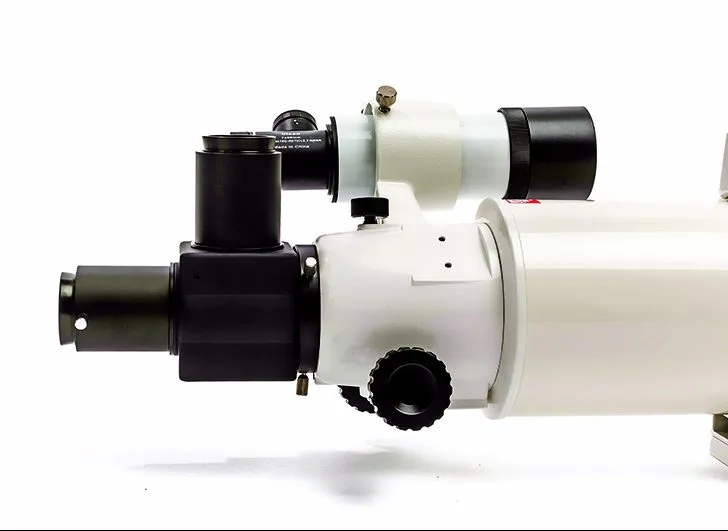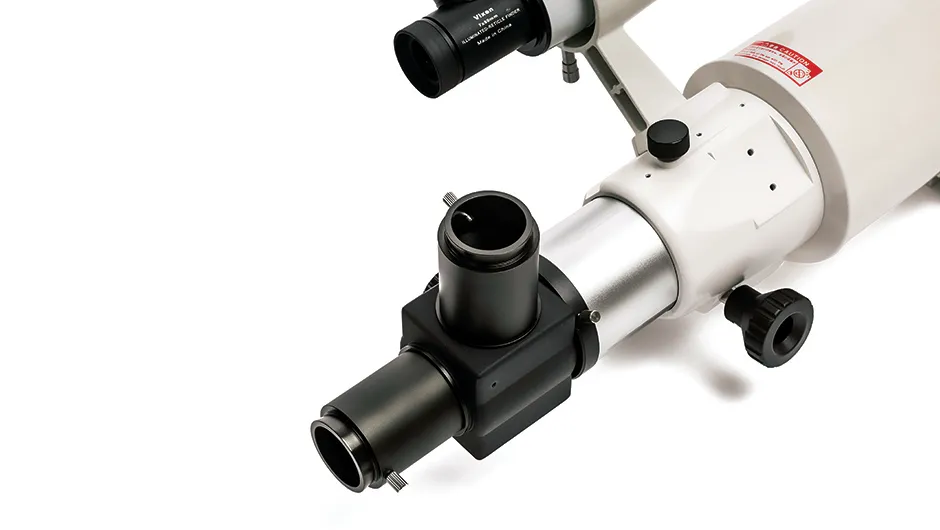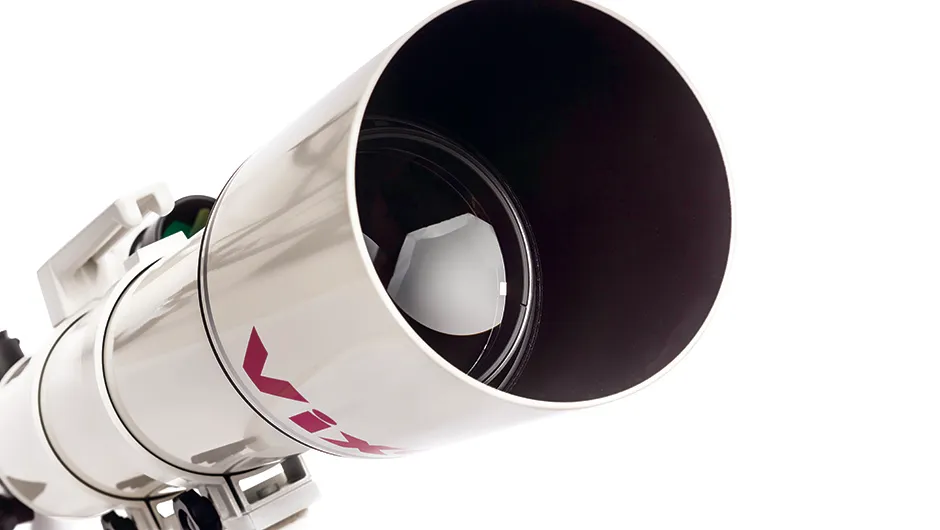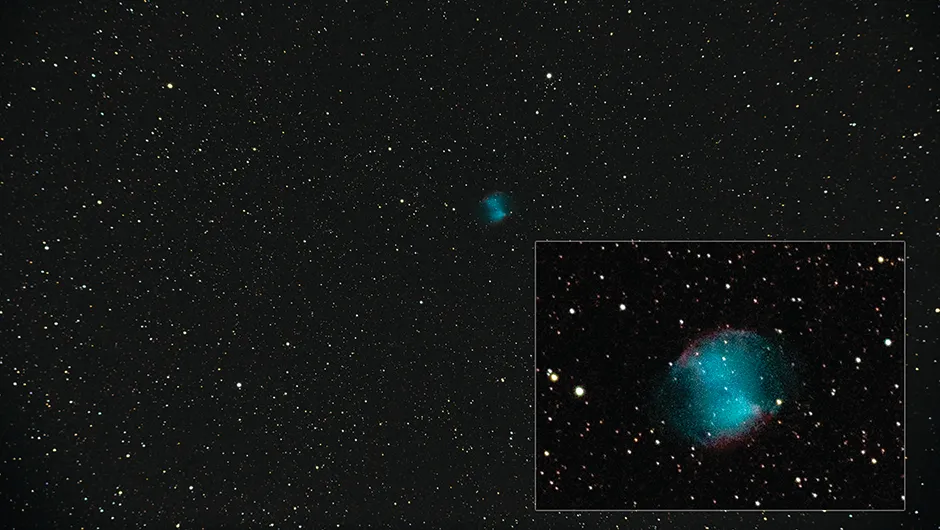Smaller aperture refractors, such as the Vixen SD103S apochromatic refractor we’re reviewing here, are a popular choice for both visual and imaging tasks.
The unobstructed aperture of these purely lens-based instruments delivers higher-contrast views that are superior to those achieved with reflectors or SCTs of similar size.
With those types of telescope, it’s the use of a secondary mirror that diffracts incoming light and ultimately reduces the view’s contrast.
Where refractors do fail, though, is in terms of price per millimetre of aperture.A large aperture reflector or SCT will typically cost significantly less than a similarly sized refractor.
In addition, while a large SCT is relatively easy to handle, a large refractor will typically be long, heavy and unwieldy.
The Vixen SD103S has a 103mm objective lens with a focal length of 795mm, making it an f/7.7 mid-speed instrument.This means that as well as being a fine instrument for visual work, the SD103S should make a superb imaging telescope.
The SD103S’s internal baffles have been redesigned from previous models to allow large sensors, such as those found in full-frame DSLRs, to be fully illuminated.
In our tests we found that although this was the case, an amount of vignetting still occurs in the extreme frame corners, an issue easily fixed by flat-field calibration.

The focuser draw tube has a 60mm thread and is supplied pre-fitted with a 2-inch adaptor ring. The focuser is of the Crayford-style.
Adjustments are basic with just a focuser stiffness tension knob.
Tightened, this locks the focuser in position.
We were impressed with the strength of the lock – even a heavy camera with a bit of manual assistance wouldn’t budge.
Balancing act
The SD103S weighs in at 4.7kg and is extremely portable. A carry handle makes it very easy to transport and lift onto a mount.
The supplied mounting plate is of the classic Vixen type rather than a rail and requires a smaller Vixen mounting clamp for a secure connection.
Once mounted, the tube rings are easily loosened and tightened to allow the telescope to slide back and forth for balancing.
A flip-mirror diagonal is supplied.

This slides into the 2-inch focuser adaptor ring and presents two T-threads onto which extension tubes and 1.2-inch adaptors are attached.Removing an extension tube allows a T-threaded camera to be connected directly to the diagonal.
The views through the scope were impressive.The Double Cluster in Perseus, NGC 869 and NGC 884, appeared bright and vibrant with good colour definition.A view of the Orion Nebula, M42, showed lots of detail.
The faint outer regions were also beautifully revealed by the scope’s high-contrast optics.It was a real pleasure to view this object through the SD103S.
A brighter test view of the Moon showed the apochromatic optics of the SD103S to be true to form, and no colour fringing was seen at any point around the Moon’s limb.
Using a 5mm Vixen eyepiece (not included) delivered a very comfortable view of the lunar surface with features as small as 10km visible under really quite unsteady conditions.
Similarly, imaging with a camera attached was a pleasurable, stress-free experience.
The focuser is responsive and excellent at holding position.It was lovely to image with such a bright, high-contrast field of view.
On a less positive note, bright stars exhibit a diffraction pattern, which appears to originate from the clips used to hold the objective in place.

In addition, large sensor images do show some optical distortion of stars towards the corners of the imaging frame.
An optional matching Vixen reducer/field-flattener goes some way to alleviating the distortions, but in our experience didn’t fully eliminate them.Despite this, approximately 85 per cent of the inner frame still produced a great image.
The Vixen SD103S is a strong performer both visually and photographically.Its portability is another factor in its favour too.Consequently, this is a no-fuss instrument that is capable of delivering excellent results.
Top performing optics
Without doubt, the stand-out feature of the SD103S telescope is its optical performance.
Basic refractors suffer from chromatic aberration; this is when short, mid and long wavelengths of visible light appear to reach slightly different focus positions, and cause colour fringing, an effect most visible on the sharp edges of bright objects such as the Moon.
The SD103S uses a 103mm diameter doublet lens to reduce this effect.
Further improvements occur through the use of FPL-53 glass, a material highly regarded for its low dispersion of different light wavelengths, and which on its own is able to keep chromatic aberration low.
The use of this high-performance optical glass is where the ‘SD’ (Super extra-low Dispersion) comes from in the telescope’s name.
As a result the SD103S produces stunning, high-contrast views.
Diffuse objects such as the Orion and Dumbbell Nebulae are extremely clear, star clusters are vibrant and the shapes of galaxies such as Bode’s Galaxy, M81, and the Cigar Galaxy, M82, are easy to make out.

Lightweight tube
The SD103S’s lightweight tube is strong, well built and attractively finished in standard Vixen colours.
Inside the tube an improved baffle system increases the amount of light delivered to the edge of large camera sensors compared to previous generation Vixen refractors.
A plastic dust cover clips into the end of the non-retractable dew shield.
7x50 finder
A generous 7x50 illuminated finder is supplied.
With 7x magnification and 50mm aperture optics, this provides a bright and easy-to-identify section of sky.
The finder attaches to the main scope via a three-screw, adjustable mounting.
An internal red LED illuminates the finder’s cross-hairs to make pointing the scope that bit easier.
Tube rings
The supplied tube rings are clamped and locked onto the telescope body via two thumb screw knobs.
Loosening and tightening for tube balance adjustment is easy thanks to the rings being felt lined.
A Vixen dovetail plate is provided as standard. A useful carry handle is attached to the top of the rings.
Flip-mirror diagonal
A flip-mirror diagonal unit is provided.
This incorporates an internal mirror moved via an external knob.
One position puts the mirror out of the way with the focus position aligned along the telescope’s optical axis.
In the 45° position, the focus point is sent to a second eyepiece barrel at 90° to the scope’s optical axis.
Focuser
The focuser is a single-speed unit, which proved responsive and smooth.
Apart from the focuser knobs, there’s just one adjustment in the form of a tensioning knob, which also locks the drawtube.
There is no ability to rotate a camera after focus has been achieved.
Price: £1649.00
Aperture: 4-inch (103mm)
FocalLength: 795mm (f/7.7)
Weight: 4.7kg (10.4lbs)
Supplier: Tring Astro
Telephone: 01442 822997
Website:www.tringastro.co.uk
This review originally appeared in the January 2019 issue of BBC Sky at Night Magazine
